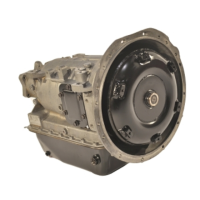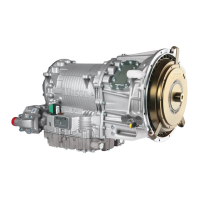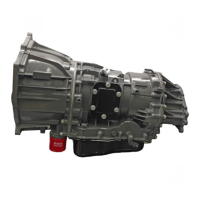Copyright © 1996 General Motors Corp. 2–7
DESCRIPTION AND OPERATION
(5) The retarder priority valve allows the
regulator valve to feed the retarder if transmission
fluid pressure is at an acceptable level. This is done to
prevent the apply of the retarder from occurring if
main pressure is at a low enough level that the trans-
mission would be unable to acceptably transmit the re-
tarder torque. The priority valve also acts as a retarder
capacity interrupt during transmission range shifts,
preventing transmission clutch overloads. The priority
valve strokes as a result of the usual transmission main
pressure drop that occurs when filling a clutch during a
range shift. This pressure drop results in the retarder
priority valve closing, and retarder capacity being re-
duced during the shift. This interruption in retarder is
so brief that no negative impact on performance is
noted. The brief capacity reduction also improves the
quality of the downshift while the retarder is activated.
(6) The retarder control system has the abil-
ity to incorporate two levels of braking, using a special
regulator valve. The regulator valve balances retarder
charging pressure against a resisting force that varies
at two levels dependent upon the capacity level cho-
sen.
(7) For the lower capacity (50 percent), the
valve spring force acts alone to balance the charging
pressure to produce torque. The first stage solenoid
(Solenoid
H
) is the only solenoid energized for this ca-
pacity level.
(8) The control system for the higher capac-
ity level (100 percent) uses the second stage solenoid
(Solenoid
F
) in addition to the first stage solenoid. The
hydraulic output from Solenoid
H
supplements the
spring force via a small plug valve. This raises the
charging pressure required to establish a force balance
on the regulator valve, resulting in higher braking out-
put when both solenoids are energized.
(9) Retarder torque is generated by the rotat-
ing rotor blades which pump transmission fluid into a
set of stationary stator blades. The stationary blades, in
turn, redirect the fluid back to the rotating blades. The
result is a very high velocity hydraulic flow around the
torus and the absorption of a large amount of kinetic
energy. Cooler flow results from the large pressure
drop that the high velocity fluids create between the
inlet and outlet locations.
2–17. MAIN CONTROL VALVE
ASSEMBLY
Main control valve body assembly 1 (Foldout 11) in-
cludes valves, springs, and other components which
respond to the manual selection of ranges and control
the automatic shifting of the transmission. The valve
body assembly is bolted to the bottom of the transmis-
sion housing. The transmission housing is channeled
to direct the flow of transmission fluid between the
valve body and clutches and other components.
2–18. HYDRAULIC SYSTEM
NOTE:
References to up, down, left, or right refer to posi-
tions or movements of components on Foldout 5 or 6.
a. System Functions.
The hydraulic system gen-
erates, directs, and controls the pressure and flow of
hydraulic fluid within the transmission. Hydraulic
fluid (transmission oil) is the power transmitting me-
dium in the torque converter. Its velocity drives the
torque converter turbine. Its flow cools and lubricates
the transmission. Its pressure operates the control
valves and applies the clutches.
b. System Schematic
(Foldout 5 or 6)
. Color-
coded foldouts of the hydraulic systems are presented
at the back of this manual. The illustrations represent
the system as it functions in neutral with the engine
idling.
c. Filter, Pump Circuit.
Transmission fluid is
drawn from the sump through a filter screen by the in-
put-driven charging pump. Fluid discharged by the
pump flows to the main-pressure regulator valve. A
bypass circuit returns fluid to the pump intake when
main pressure reaches its scheduled value.
d. Main-Pressure Circuit
(Red)
(1) Transmission fluid from the pump flows
into the bore surrounding the main-pressure regulator
valve, into an internal passage of the valve, and to the
upper end of the valve. Pressure at the upper end of the
valve moves the valve downward until fluid flows to
the torque converter and, if pump flow is of sufficient
volume, to the bypass circuit. Spring force below the

